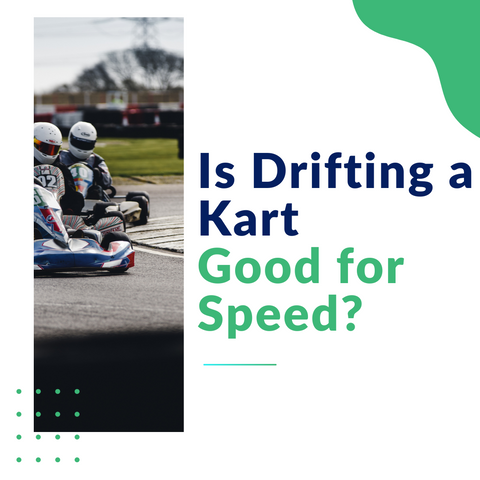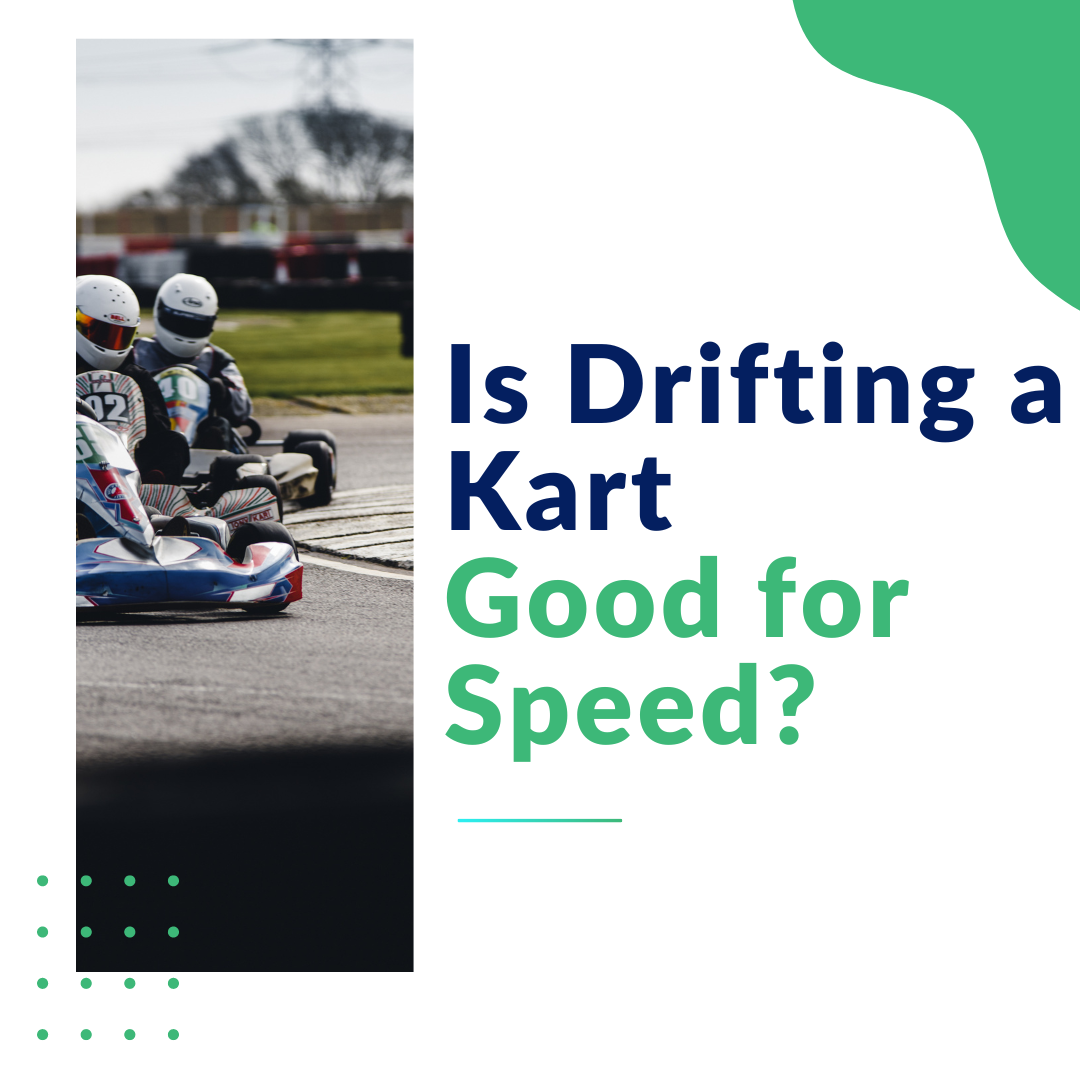Published: 5.7.23
Updated: 13.3.25
Drifting in a go-kart can seem like an adrenaline-pumping, exciting manoeuvre, and indeed, it is.
Go-karts are designed with this in mind, capturing the thrill showcased in many movies and video games that have sensationalised drifting, making it appear like the ultimate way to turn corners and overtake opponents.
But is drifting a kart good for speed?
Let's find out.
| Aspect | Description |
|---|---|
| Speed | Drifting generally slows down the kart due to loss of traction and increased turning radius. |
| Tyre Wear | Increased friction during drifting causes faster tyre wear. |
| Control | Maintaining control is more difficult while drifting compared to normal turning techniques. |
| Visual Appeal | Drifting adds a stylish element to driving but does not improve performance in races. |
The Short Answer to "Is Drifting a Kart Good for Speed?"
Drifting a kart, while exhilarating and stylish, is not the optimal strategy for speed. In kart racing, controlled turns are quicker and more efficient than drifting, which can slow the kart and disrupt momentum. Moreover, drifting can result in premature tyre wear. While certain karts are designed specifically for drifting, in a racing context, maintaining speed and momentum through accurate turns and adherence to the racing line is the superior strategy for speed.
Related: What is the Fastest Go Kart in the World?
Understanding Kart Drifting
What is Kart Drifting?
Drifting in a kart is similar to drifting in any other vehicle. It involves controlling the vehicle while most of its tyres have lost their grip on the road, resulting in a slide. 
While drifting can add style points to your ride, the real question is whether it adds to the speed as well. To fully understand this, you might want to delve into why go-karting is good for you in the first place.
Impact of Drifting on Kart Speed
While it might look visually stunning, drifting a kart can often lead to a decrease in speed.
This is because drifting results in a wider turn radius, which means your kart has to cover more ground than if it were turning normally. To get a clear understanding, here is an article on how to improve at go-karting.
The Effects of Drifting on Kart Tyres
Another important factor to consider is the health of your kart's tyres.
Drifting places a lot of strain on the tyres, causing them to wear out much faster.
This is due to the increased friction caused by drifting, which can grind down your tyres and decrease their effectiveness over time.
In a nutshell, drifting is not good for the tyres of the kart.
Related: How To Drift In A Go Kart (EASIER THAN YOU THINK)
Kart Racing Techniques
Driving on the Racing Line
In kart racing, there's a technique called 'driving on the racing line'. This is the path that provides the shortest possible distance around the track.
It's always faster than drifting because it allows for smoother turns and greater momentum.
This ultimately results in more speed and better racing performance.
Related: What is The Maximum Height for Go Karting
The Illusion of Speed in Drifting
While drifting might feel faster because of the increased g-forces acting on your body, it's actually slower than taking a corner on the racing line.
Guides that claim drifting increases speed around corners are often misguided, as they fail to consider the full science behind the manoeuvre.
Pros and Cons of Drifting a Kart
Drifting a go-kart isn't entirely negative, though. For one, it can make tight turns without losing too much speed, which could be beneficial in certain scenarios. However, these scenarios are few and far between in the world of kart racing, and the drawbacks, like speed loss and tire wear, often outweigh this minor advantage.
Practical Implications for Racers
For those who take part in kart races, it's crucial to understand the limitations and implications of drifting.
Maintaining momentum and speed is more vital than flashy drifting, especially when it's a race against time.
As such, racers should focus on proper turning and maintaining momentum for the best speed possible
It's important to note that the cost of go-karts and their maintenance also includes the frequent tire replacements due to drifting.
Improving Kart Racing Performance
Alternatives to Drifting
While drifting might not be ideal for speed, there are other techniques that can improve your kart racing performance.
One such technique is 'grip driving', which involves using the tyres' grip to maintain speed through corners.
This is usually more efficient than drifting and allows for better control over the kart.
Tips for Better Kart Racing Performance
-
Master the Racing Line: Understanding and mastering the racing line is key to fast-kart racing. The racing line is the optimal path around the track that minimises lap times.
-
Smooth Steering: Smooth steering allows you to maintain better control and speed. Abrupt steering changes can cause you to lose speed.
-
Effective Braking: Braking effectively is not just about stopping the kart but also about controlling its speed. Effective braking before turns can help maintain an optimal speed throughout the race.
-
Consistent Throttle Control: Consistent throttle control can help maintain your speed and momentum. It's important not to accelerate or decelerate too abruptly.
Conclusion: The Reality of Drifting a Kart
So, is drifting a kart good for speed? The simple answer is no. While drifting can make for a thrilling ride, it's not the fastest way around the track.
It can cause your kart to lose speed, wear out your tyres faster, and ultimately slow you down in a race.
Therefore, for those seeking speed and performance, sticking to the racing line and proper cornering techniques is the better choice.
The world of kart racing is more than just fancy manoeuvres - it's about speed, precision, and strategic gameplay.
So next time you're on the track, remember, smooth and precise turns can often be the quickest way to the finish line.
You might also want to understand why go-karting can be expensive and how much it affects the racing performance.
Latest Trends in Go-Karting
Recent trends and advancements in go-karting are shaping the future of this popular motorsport.
Here are some key developments:
-
Electrification: The adoption of electric go-karts is gaining momentum, driven by the global shift towards sustainability. Electric karts offer advantages such as reduced environmental impact, quieter operation, and instant torque for thrilling acceleration. This trend is expected to continue growing as electric technology advances.
-
Technological Innovations: Go-karts are becoming more technologically advanced, with the integration of sensors, telemetry systems, and data analytics capabilities. These technologies allow drivers and teams to capture valuable performance data, optimize kart setups, and fine-tune their racing strategies.
-
Safety Improvements: Advancements in safety features are contributing to the market's expansion. Manufacturers are focusing on developing safer go-karts to address concerns and attract more participants.
-
Innovative Racing Formats: The sport is evolving to include new and exciting race formats, such as endurance karting events, sprint races, time trials, and gymkhana-style races. These formats encourage strategic thinking, teamwork, and create diverse experiences for drivers and spectators.
-
Increased Accessibility and Inclusivity: There's a growing focus on making go-karting more accessible to a wider audience. This includes expanding karting facilities to reach more regions and implementing initiatives like karting academies and grassroots programs to nurture young talent.
-
Market Growth: The global go-kart market is projected to grow significantly in the coming years, driven by factors such as increasing population, rising purchasing power, and the growing number of race courses and country clubs.
-
Diversification of Go-Kart Types: The market offers various types of go-karts to cater to different preferences, including gasoline-powered, electric, and off-road go-karts. This diversification allows for a broader range of applications, from recreational use to professional racing.
These trends and advancements are collectively shaping the future of go-karting, making it more sustainable, technologically advanced, and accessible to a wider audience while maintaining its thrilling and competitive nature.
Safety First: Essential Tips for Drifting Safely
Drifting, a thrilling and visually striking motorsport manoeuvre, requires stringent safety measures and best practices to ensure the safety of drivers and spectators.
Here are detailed safety measures and best practices for drifting:
Vehicle Safety
- Roll Cage: A roll cage is essential to protect the driver in case of a rollover. It should comply with industry standards, particularly for competitive divisions.
- Safety Harness: A proper racing harness keeps the driver securely in place, reducing the risk of injury during high-speed maneuvers.
- Seats: Racing seats provide better support and safety compared to standard seats, helping to keep the driver in position during aggressive driving.
- Helmet: Wearing a helmet is mandatory to protect the head from impacts.
- Fire Extinguisher System: All cars should be equipped with a plumbed-in fire extinguisher system to quickly address any fire incidents.
- Circuit Breaker: A general circuit breaker that can cut all electrical circuits is recommended for all vehicles to prevent electrical fires.
- Fuel Tank: Vehicles should have an approved safety fuel tank to minimise the risk of fuel leaks and fires.
Track Safety
- Designated Tracks: Drifting should be performed on designated tracks with proper safety barriers and runoff areas to minimise the risk of collisions and injuries.
- Crash Protection: Tracks should have adequate crash protection, such as tire walls or concrete barriers, to absorb impacts and protect drivers.
- Emergency Services: Tracks should have emergency services on standby, including medical personnel and fire response teams, to quickly address any incidents.
Best Practices
Pre-Event Preparation
- Vehicle Inspection: Conduct thorough inspections of the vehicle to ensure all safety equipment is in place and functioning correctly. This includes checking the roll cage, harnesses, seats, and fire extinguisher system.
- Driver Training: Drivers should undergo proper training to handle the dynamics of drifting and understand the safety protocols.
During the Event
- Adherence to Rules: Follow all event-specific rules and regulations, including those set by the governing bodies, to ensure a standardised approach to safety.
- Controlled Environment: Perform drifting in a controlled environment with clear boundaries and safety measures in place. Avoid public roads to prevent accidents and legal issues.
- Communication: Maintain clear communication with event organisers and other drivers to coordinate movements and avoid collisions.
Post-Event
- Vehicle Maintenance: Regularly maintain and inspect the vehicle after each event to ensure it remains in safe working condition.
- Incident Reporting: Report any incidents or near-misses to event organisers to help improve safety measures for future events.
By adhering to these safety measures and best practices, the risks associated with drifting can be significantly reduced, ensuring a safer experience for all participants.
FAQs
What is the difference between a go-kart made for drifting and a regular go-kart?
Drift karts and regular go-karts vary in design and purpose. Drift karts are tailored for drifting with a focus on oversteer conditions and rear-wheel drive for greater drift control.
Conversely, regular go-karts concentrate on speed and handling with a design for optimal turning, usually using the front-wheel drive.
Though outwardly alike, drift karts cater to drift enthusiasts while regular go-karts prioritise speed and manoeuvrability.
How does drifting affect the handling of a go-kart?
Drifting influences a go-kart's handling in several noteworthy ways. It can reduce the kart's speed, offering rivals a competitive edge, and it intensifies tyre wear. Maintaining momentum and control becomes challenging during drifting, and the kart might experience extreme oversteer, leading to further speed reduction. Lastly, drifting results in a larger rear slip angle compared to the front, complicating kart control. Despite its thrill, drifting during races isn't advisable as it compromises the kart's speed and handling. It's preferable to concentrate on precise turning and momentum conservation for optimal speed.
What are some other techniques to increase speed in a go-kart?
Enhancing a go-kart's speed involves several steps. Firstly, upgrade your kart with a stronger engine, better suspension, or brakes. Secondly, optimise your carburettor's air/fuel mixture for maximum engine performance. More intense improvements include adding a supercharger or turbocharger to boost engine power and re-gearing your kart with a smaller sprocket to increase engine force on the axle. Lightening your kart by removing unnecessary parts or using lighter materials also boosts speed and acceleration. Similarly, speed gains can be achieved by removing the speed governor. Larger tyres can enhance top speed if supported by a powerful engine. Lastly, adding isopropyl alcohol to your fuel can increase your kart's speed and horsepower.
Related: What Are the Best Go-Kart Gear Ratios?
Get in Touch 🚀
Loved our article on “Is Drifting a Kart Good for Speed?” Got the itch to dive into more wheely-awesome info?
Whether you're a parent or a grandparent, we're here for all your kids ride-on toy questions! 🚗💨
Feeling click-happy?
Jump straight into our wonderland at RiiRoo.com.
Or, if you're more the chatty type, give our Live Chat a whirl and let's talk toys!









Share:
How To Tell When Your Quad Needs An Oil Change
Understanding the Racing Line: Unleash Your Inner Speed Demon